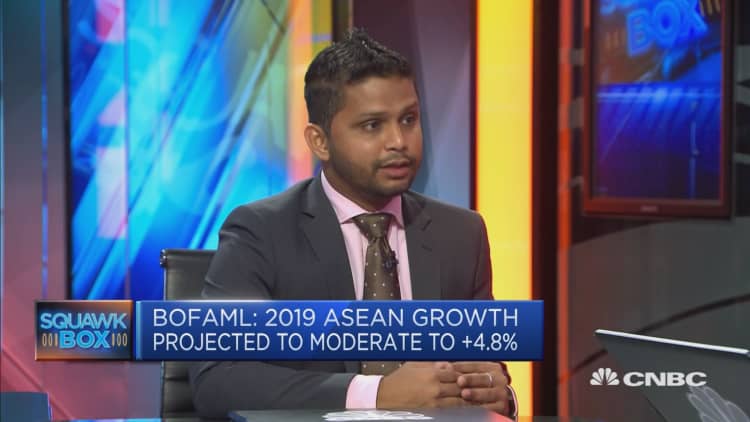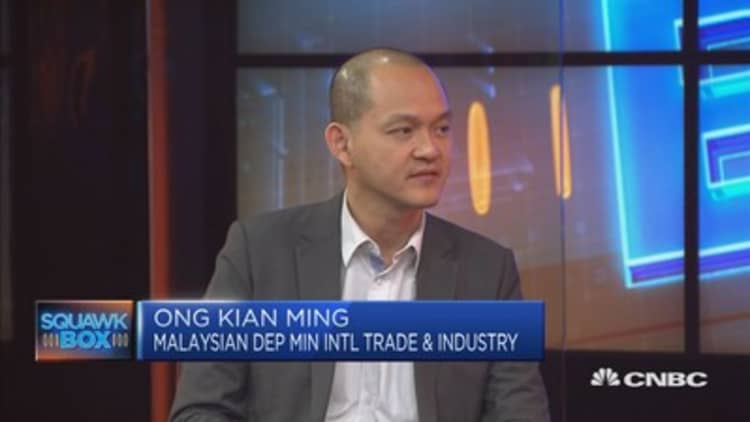When U.S. President Donald Trump came to power two years ago, his government unveiled several actions under the "America First" doctrine that reduced American engagement with the international community. From withdrawing from a massive Pacific trade deal to threatening import tariffs on long-standing allies, the Trump presidency has sparked worries about the state of America's leadership on the global stage.
Over the past year, however, Washington has taken pains to show the Asia-Pacific region that it remains a steadfast partner. High-ranking U.S. officials have prioritized the area for official visits while the U.S. has announced significant funding and military support for Asian governments under its Indo-Pacific blueprint.
But a number of emerging Asian economies still remain skeptical of American commitment. Washington may have pledged millions and deployed ships to the area, but many in Southeast Asian countries doubt the stability of such promises, strategists told CNBC.
Trump's administration has become unpredictable with policy flip-flops and the departures of respected policymakers such as former Defense Secretary James Mattis, so it's difficult to gauge any U.S. action with certainty, said Collin Koh Swee Lean, a research fellow specializing in Southeast Asian defense at Singapore's Nanyang Technological University.
The biggest question is always about whether the administration will follow up with implementationCollin Koh Swee LeanNanyang Technological University
In July of last year, the U.S. announced $113 million in infrastructure spending for the "Indo-Pacific" region, the Trump administration's preferred term for the more widely used "Asia-Pacific." That was followed by the creation of a new development finance agency with a lending cap of $60 billion, which stakeholders described as "a clear alternative" to Chinese investment in Asia. Countering China's military, economic and financial firepower is widely seen as a primary rationale behind many U.S. policies.
Washington's latest demonstration of allegiance to Asia is a bill called the Asia Reassurance Initiative Act, or ARIA, which Trump signed into law on Dec. 31. It promises Asia-Pacific nations $1.5 billion annually over the next five years in the areas of counter terrorism, trade, human rights and security.
Southeast Asia doesn't seem convinced
According to a survey of 1,008 stakeholders from Southeast Asia's policy, research, business, civil society and media communities, 68 percent believe U.S. engagement with the region has decreased since Trump came to power.
The poll, conducted between Nov. 18 and Dec.5 by the ISEAS-Yusof Ishak Institute, a Singapore think tank, also indicated a pessimistic view on the Trump administration. Only 31.9 percent of respondents said they had confidence in Washington's reliability as a strategic partner and provider of regional security.

"About three out of four Southeast Asians (74.1%) expect China to vie for political leadership in response to the growing indifference of the US towards Southeast Asia and ASEAN," a report on the survey results added. While the poll reveals significant uncertainty over America's role in Southeast Asia, it doesn't mean the world's largest economy is unwanted or unwelcome in the region, the institute cautioned.
"The survey shows that President Trump has hurt the standing of the US in Southeast Asia," said Malcolm Cook, senior fellow at the think tank. "This means that the Asia Reassurance Initiative and other policies will be a hard sell for the Trump administration."
What the US can do
For Washington to win back the region's confidence, experts say delivery is key.
Initiatives such as ARIA and the infrastructure fund are welcome "but the biggest question is always about whether the administration will follow up with implementation," said Koh, adding that another goal should be the promotion of "greater cooperation with allies and partners."
The superpower has repeatedly stressed its desire to work with allies but that tends to get overshadowed by other issues such as its demand for defense cost sharing, Koh said: "That's one example when close U.S. allies would start to question the American commitment and their own roles in the broader equation."

Others recommend the U.S. show more of its face in the region.
"One of the main concerns is the lack of top-level attention on Southeast Asia, as demonstrated by President Trump's decision not to attend the ASEAN East Asia Summit or APEC Summit in November," said Hunter Marston, an independent Southeast Asia analyst based in Washington, DC. "That marks a major contrast with the administration of Barack Obama, who took a keen personal interest in the region."
The ongoing U.S-China trade war is another issue that impacts Asia's perceptions of Washington.
"While many Southeast Asian partners may privately support the Trump administration's willingness to stand up to Chinese regional coercion, publicly Asian leaders remain wary of the geopolitical pressure to choose sides between Washington or Beijing," Marston continued.
Many are already discussing what the world could look like if countries no longer have the option of trading and working with both economic heavyweights.

